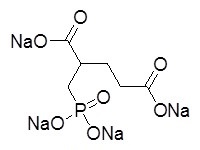All AbMole products are for research use only, cannot be used for human consumption.

In vitro: 2-PMPA (PMPA tetrasodium salt) is a potent and selective inhibitor of GCPII, an enzyme which catabolizes the abundant neuropeptide N-acetyl-aspartyl-glutamate (NAAG) to N-acetylaspartate (NAA) and glutamate. 2-PMPA demonstrates robust efficacy in numerous animal models of neurological disease. 2-PMPA is a highly polar compound with multiple negative charges causing significant challenges for analysis in biological matrices.
In vivo: Intraperitoneal administration of 100 mg/kg 2-PMPA results in maximum concentration in plasma of 275 μg/mL at 0.25 h. The half-life, area under the curve, apparent clearance, and volume of distribution are 0.64 h, 210 μg×h/mL, 7.93 mL/min/kg, and 0.44 L/kg, respectively. 2-PMPA at 250 mg/kg, in an anesthetized mouse, after an initial rise, produces a rapid decline and a striking attenuation in BOLD signals in gray matter. The signature of 2-PMPA on brain T2* signals in gray matter at both 167 and 250 mg/kg includes a significant initial rise lasting several minutes.
CAS#: 173039-10-6(free base)

Front Cell Dev Biol. 2021 Mar 4;9:598377.
Prostate-Specific Membrane Antigen (PSMA) Promotes Angiogenesis of Glioblastoma Through Interacting With ITGB4 and Regulating NF-κB Signaling Pathway
2-PMPA tetrasodium purchased from AbMole
| Cell Experiment | |
|---|---|
| Cell lines | Neuronal cultures |
| Preparation method | 2-PMPA is selected to explore the protective effect on ketamine-induced neurotoxicity in these two different cell cultures. Cells are exposed to 2-PMPA (20, 50, 100 μM) half an hour before 10 μM ketamine treatment in neuronal cultures and 2 mM ketamine treatment in neuron–glia mixed cultures for 24 h. Different doses of ketamine chosen in neuronal cultures and neuron–glia mixed cultures are based on the results of cell viability tests. |
| Concentrations | 20, 50, 100 μM |
| Incubation time | 24 h |
| Animal Experiment | |
|---|---|
| Animal models | Male Wistar rats |
| Formulation | 50 mM HEPES buffered saline |
| Dosages | 80 mg/kg |
| Administration | i.p. |
| Molecular Weight | 314.05 |
| Formula | C6H7Na4O7P |
| CAS Number | 373645-42-2 |
| Solubility (25°C) | Water ≥ 10 mg/mL |
| Storage | 4°C, dry, sealed |
| Related Products |
|---|
| DSPE-PEG-FA
DSPE-PEG2K-FA is a PEG derivative containing folic acid. DSPE-PEG2K-FA has a targeting effect and can bind to folic acid receptors in cancer cells. DSPE-PEG2K-FA forms micelles/lipid bilayers and can be used in research on targeted drug delivery systems. |
| Lifastuzumab
Lifastuzumab is a humanized anti-NaPi2b IgG1 monoclonal antibody. |
| GPVI antagonist 1
GPVI antagonist 1 is a glycoprotein VI (GPVI) platelet receptor antagonist. GPVI antagonist 1 inhibits collagen-induced platelet aggregation with an IC50 of 25.3 μM. |
| MPSD TFA
MPSD TFA (MARCKS-ED TFA) is a 25-amino acid peptide based on the effector domain sequence of the intracellular membrane protein myristoylated alanine-rich C-kinase substrate (MARCKS). MPSD TFA can sense membrane curvature and recognize phosphatidylserine. MPSD TFA can be utilized as biological probe to study membrane shape and lipid composition. |
| 4-Nitro-2,1,3-benzoselenadiazole
4-Nitro-2,1,3-benzoselenadiazole is a biochemical material that can be used in scientific research. |
All AbMole products are for research use only, cannot be used for human consumption or veterinary use. We do not provide products or services to individuals. Please comply with the intended use and do not use AbMole products for any other purpose.


Products are for research use only. Not for human use. We do not sell to patients.
© Copyright 2010-2024 AbMole BioScience. All Rights Reserved.
